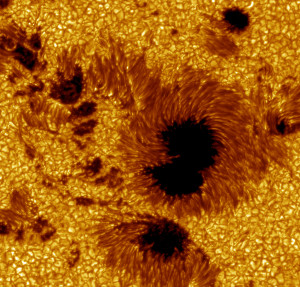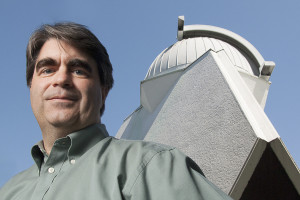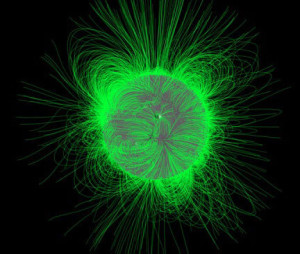Here at Science World, one of our favorite topics is the sun. We’ve been able to provide you with a number of informational pieces regarding events and phenomena such as the ebb and flow of the sun’s activity throughout its roughly 11 year solar cycle.
As the sun goes through this process – from when it’s least active (solar minimum) to its most active (solar maximum) and back again – it undergoes what scientists describe as a “complete makeover” when its magnetic field reverses or flips its polarity. The sun’s magnetic north becomes its south and vice versa, causing effects that can ripple throughout our solar system.
Scientists say that our sun, which is nearing the peak of its current solar cycle, is about to flip its magnetic poles. The current solar cycle that began in 2008 or 2009 is the 24th since scientists started tracking them back in 1755. Compared to previous solar cycles, researchers have said that the current cycle appears to be weaker than any other before it, perhaps the weakest in 100 years.
While not much is known about the actual mechanics behind this polarity flip, solar scientists at Stanford University’s Wilcox Solar Observatory are keeping an eye on the sun’s magnetic field, monitoring and measuring it every day, as they have done since 1975.

Large field-of-view image of sunspots. The image has been colored yellow for aesthetic reasons. (Royal Swedish Academy of Sciences)
The daily monitoring efforts allow these researchers to observe and identify the magnetic polarity reversal as it actually takes place on the sun’s surface. This upcoming shift in the Sun’s poles will be the fourth the observatory has watched.
While we laypeople tend to label the sun’s magnetic poles as north and south, Todd Hoeksema, a solar physicist and Director of the Wilcox Solar Observatory, suggests that we think of the poles as positive and negative. “It’s best not to think of it like a big bar magnet. That works OK for Earth but not the Sun. Think of the Sun as having a large number of smaller magnetic fields scattered over the surface,” he said.
Of course, hearing that the sun is about undergo a significant event like a pole reversal can alarm some people who may wonder if they might be in danger. But, according to Hoeksema we have nothing to worry about.
“When it happened about eleven or twelve years ago, you probably didn’t even notice,” he said.
Hoeksema explains that the pole reversal process takes place over time throughout the solar cycle where sunspots come up at the Sun’s mid-latitudes (equator) and spread out toward its poles. Gradually, as the magnetic flux (a measurement of the quantity of magnetism) that comes up with the sunspots moves pole-ward it erodes the existing polar fields and replaces them with magnetic fields that have the opposite polarity.
“What we’re seeing recently is more activity in the (sun’s) southern hemisphere and that’s the pole that’s just about to switch or is switching right now,” said Hoeksema.
He also pointed out that the sun’s northern pole switched about a year ago in the summer of 2012.
The sun’s two hemispheres (north and south) aren’t in perfect synchronization with each other and the number of sunspots that emerge in each of the hemispheres can be different.
Because of this, according to Hoeksema, the sun’s ‘new’ polarity that moves poleward is generally different in the north and south in both timing and strength which causes one geographic pole to change its magnetic field direction before the other.
Since it is at or near its peak of activity, the sun is has been pumping out a lot of energy particles throughout the solar system via the solar wind. Because of this outpouring of sun particles, according to Hoeksema, we’re actually being shielded from the high energy particles that come at us from other parts of the galaxy.

Todd Hoeksema from Stanford University monitors the sun’s magnetic field at Stanford’s Wilcox Solar Observatory. (Photo: Linda A. Cicero /Stanford News Service)
Along with their ground-based Wilcox Solar Observatory at Stanford, Hoeksema and his fellow scientists also use some sophisticated observational tools in space, too. One is as an instrument aboard NASA’s Solar Dynamic Observatory (SDO) called the ‘Helioseismic and Magnetic Imager’ (HMI) which allows the team to measure the sun’s magnetic field every 45 seconds.
These measurements help scientists zero in on where and what kind of solar activity is taking place on the Sun, something that Hoeksema and his colleagues hope will help scientists better predict potentially dangerous space weather.
Dr. Todd Hoeksema joins us this weekend on the radio edition of “Science World.” To listen to our conversation either tune into the show (see right column for scheduled times) or check out the interview below.
Also check out the video below.
Solar physicist Todd Hoekserma explains sun’s magnetic reversal (Stanford University)























I heard that birds and animals sense some of the natural changes or disasters early. In Canada, i heard and i myself saw, about large number of birds gathering in open grounds and on trees. They should have left our region by now for warmer weather. I am guessing something is related to the magnetic fields.
Sounds worse than actually is, truly it doesn’t affect us in almost anything important….
Actually it could effect our power grids creaTing a blackout similar to an emp attack. Possible but unlikely.
I also believe the change of the suns poles could greatly effect the core of our planet in a detrimental way. Changing the hold that gravity from the sun has on our planet, which in turn changes the composure holding our tectonic plates and magma flow beneath the crust of earth. This could cause climate change by tilting our planet and soon shifting our poles towards the equator. There are a lot of factors and this is just my
hypothesis.
Weather will dictate the actual outcome and I do believe we are past due for an ice age. People have the right to worry about what cant be controlled which is nature.
Did you guys not read this article? The poles shift every 11 years, meaning that if you have lived over 11 years you have lived through it flipping without any issues. It has been happening for millions of years, so I wouldn’t be concerned.
I’m just a lay person buI heard that it affects our Ozone layer in a positive way? So interesting just to search and see what’s going on.
Is this about to happen as Comet ISON is at it’s closest with the sun, and would we see any effects from this?
Nothing to do with comets.
The sun has an 11 year cycle with most activity in the final year. This emits enormous amount of radiation and magnetic fields which in turn affects currents and amount of magnetric fields at nth and sth pole of earth thus affecting the Jet Stream location and to an extent its speed. This affects weather constantly..
When the sun flips its magnetic fields from nth to sth, basically all hell breaks loose. Thus our weather this last few months been unusual. Forget man’s impact. A tiny midget or pygmy in comparison. BUT, we have 3,000 scientists and their families plus several thousand journalists worldwide whose livlihood depends on them reporting about global warming. SO, Turkeys do not vote for Xmas!!!!!!!!!!!!